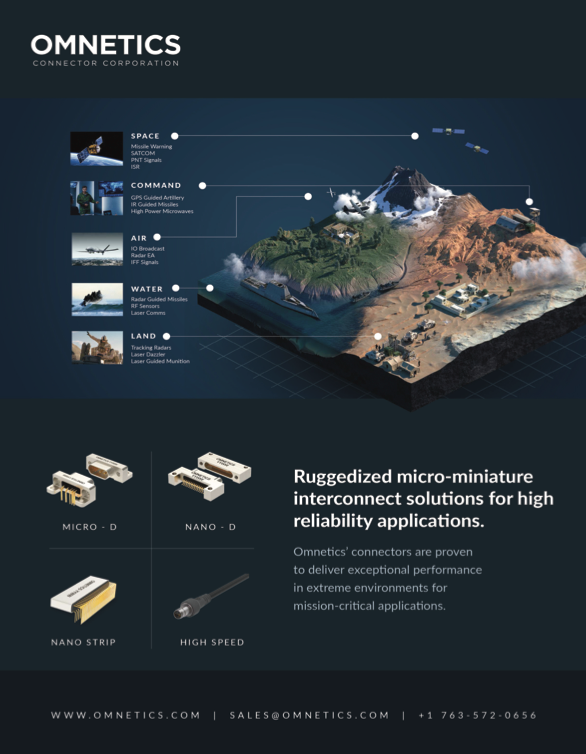Raytheon Technologies awarded SDA contract for a missile warning + tracking constellation
Raytheon Technologies (NYSE: RTX) has received an award valued at more than $250 million to design, develop and deliver a seven-vehicle missile tracking satellite constellation, as well as support launch and ground operations by the Space Development Agency.
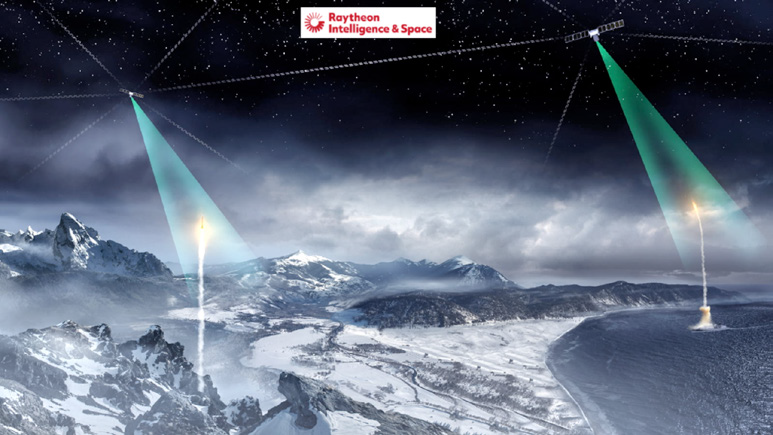
Once deployed, the LEO constellation of networked satellites will become the fifth plane of satellites providing missile warning and tracking for the Department of Defense (DoD). The program is a key element of the Proliferated Warfighter Space Architecture.
Raytheon Technologies has been developing missile warning systems for decades. Since acquiring Blue Canyon Technologies and SEAKR Engineering, Raytheon Technologies has expanded its space payload and satellite bus capabilities and expertise, becoming a leading provider of space systems to a growing number of programs.
Raytheon will leverage existing designs, available commercial products and common components to reduce technical risk and speed delivery.
The seven-vehicle satellite constellation will feature Raytheon’s Wide Field of View overhead persistent infrared sensor, Blue Canyon Technologies’ Saturn-class smallsat bus, and SEAKR Engineering’s electronics payload.
Space Systems Command (SSC) collaborates with NASA to launch Space Test Program-H9 experiments to the ISS
Space Systems Command (SCC) is preparing to launch the Space Test Program-Houston 9 (STP-H9) mission to deliver eight DoD Space Test Program (STP) experimental payloads to NASA’s International Space Station (ISS).
NASA’s ISS will host the experiments for one year. Once docked to the ISS, the STP-H9 payload will be robotically installed on the Japanese External Facility where it will get power and data to support the eight experiments.
The STP-H9 mission, in partnership with NASA’s ISS Program, the U.S. Naval Research Laboratory (NRL), the U.S. Air Force Research laboratory (AFRL), the U.S. Air Force Academy, and Lawrence Livermore National Laboratory (LLNL), is scheduled to launch on SpaceX’s Commercial Resupply Service (CRS)-27 mission aboard a Cargo Dragon spacecraft from Kennedy Space Center, Florida on March 14.
“This mission marks another milestone in the valuable partnership between SSC and DoD’s Space Test Program and NASA and continues the STP’s 58-year history of providing access to space for emerging DoD technologies. This is STP’s 305th mission in its
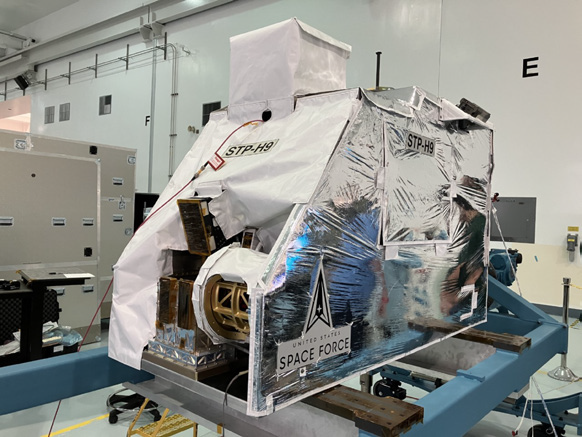
Space Systems Command (SCC) prepares the Space Test
Program-Houston 9 (STP-H9) mission containing eight DoD
Space Test Program (STP) experimental payloads in the
NASA Kennedy Space Center (KSC) Space Station
Processing Facility (SSPF) before being turned over to
NASA for a March 14 launch aboard the SpaceX’s
Commercial Resupply Service (CRS)- 27 mission from
Kennedy Space Center, Florida. (Photo courtesy of DoD
Space Test Program)
58-year history,” said Lt. Col. Jonathan Shea, SSC director of the DoD STP.
STP operates from a prioritized list of critical space technologies that require testing in the space environment in order to ensure their maturity for future space capabilities. STP is the catalyst creating partnerships and developing payloads and support operations.
“We have a great partnership with the ISS Program,” said Rick Caldwell, SSC mission manager for the STP-H9 payload. “Our STP missions fly alongside NASA and international partner payloads in a continuous research process that has been ongoing for more than 20 years. It is incredibly complicated to build a payload to meet the hundreds of requirements and interfaces to make this all work. Because the ISS is already in orbit, the first chance we get to actually connect the payload to the ISS will be after we launch. We only get one shot, there is no room for error.”
STP-H9 is managed by the DoD Space Test Program office located at Kirtland Air Force Base in Albuquerque, New Mexico, and has an Operating Location at NASA’s Johnson Space Center, Houston, Texas.
SSC’s Space Domain Awareness & Combat Power, headquartered at Los Angeles Air Force Base, administers the DoD STP, which delivers experimental demonstrations of new capabilities and expedient space access solutions for R&D experiments.
Space Systems Command (SCC) prepares the Space Test Program-Houston 9 (STP-H9) mission containing eight DoD Space Test Program (STP) experimental payloads in the NASA
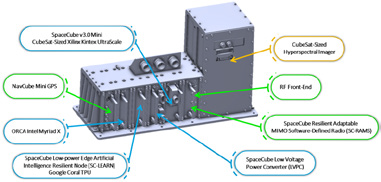
The Space Test Program – Houston 9 – SpaceCube Edge-Node Intelligent Collaboration (STP-H9-SCENIC) investigation mechanical closure and labeled components. (Image courtesy of NASA
Kennedy Space Center (KSC) Space Station Processing Facility (SSPF) before being turned over to NASA for a March 14 launch aboard the SpaceX’s Commercial Resupply Service (CRS)-27 mission from Kennedy Space Center, Florida. (Photo courtesy of DoD Space Test Program)
The STP team designed and built the integrated payload that will connect the eight experiments to the ISS and allow science data collection. Avionics developed by STP are used to build and test these platforms on the ISS.
Space Domain Awareness & Combat Power is the program executive office within Space Systems Command that is responsible for delivering ground- and space-based infrastructure and systems that identify threats to national, allied, and commercial space systems. Its innovations integrate seamlessly across the space enterprise and promote deterrence by providing advances in space-enabled warfighting capabilities to our joint military forces.
Space Systems Command (SSC) is the U.S. Space Force Field Command responsible for acquiring and delivering resilient war fighting capabilities to protect our nation’s strategic advantage in and from space. SSC manages an $11 billion space acquisition budget for the Department of Defense and works in partnership with joint forces, industry, government agencies, academic and allied organizations to accelerate innovation and outpace emerging threats. Our actions today are making the world a better space for tomorrow.
ThinKom delivers SATCOM system for SNC’s RAPCON-X™ program
ThinKom Solutions, Inc. (ThinKom) has delivered their ThinAir® Ka2517 phased-array satcom antenna systems to Sierra Nevada Corporation (SNC) for installation on its new RAPCON-X aircraft.

This rapidly configurable aerial intelligence, surveillance, and reconnaissance (AISR) platform also includes next-generation mission system and signal intelligence products for multi-domain operations.
Adding the Ka2517 as part of the solution brings highly efficient satellite communications to RAPCON-X. The phased- array antenna has the agility to interoperate seamlessly with satellites in GEO and NGSO orbits, ensuring highly efficient, worldwide connectivity in a multi-orbit environment.
This configuration is supported on the RAPCON-X by a U.S. military-compliant modem, enabling real-time, reliable, and resilient broadband transmission to and from the aircraft in flight.
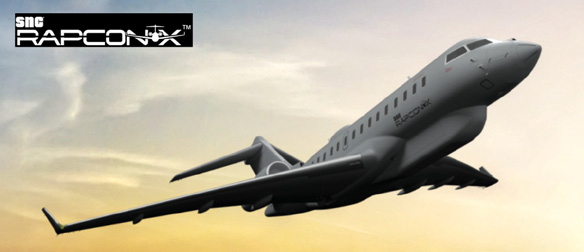
The Ka2517 is based on ThinKom’s field-proven, patented Variable Inclination Continuous Transverse Stub (VICTS) phased- array technology. VICTS antennas have more than 33 million hours of accrued flight time and a mean-time-between- failure (MTBF) exceeding 100,000 hours. Ka2517 antennas have been providing continuous service on a range of U.S. government aircraft since 2018.
Based on the Bombardier Global 6500, the RAPCON-X platform delivers superior range and endurance to facilitate immediate worldwide deployments within an operational envelope that enhances survivability.
The low-profile radome for the Ka2517 minimizes in-flight drag, resulting in lower fuel consumption and longer time on station, further enhancing RAPCON-X’s capabilities.
The RAPCON-X program aims to reduce the time required to integrate new systems or add functions in the AISR domain. Rather than requiring a complete redesign, a modular approach allows for a unique approach to the market as a contractor-owned, contractor-operated solution.
The Global 6500 base provides the space and excess electrical power to easily accommodate current mission equipment while allowing for substantial future growth in functionality.
“ThinKom’s Ka2517 antenna is a key component of the RAPCON-X airborne system-of-systems that arrives ready to complete the mission, whenever and wherever the need evolves. The open architecture platform provides robust, reliable and resilient command, control and communications capabilities, operating across multiple satellites and constellations and using multiple waveforms, including those enabling specialized cryptographic capabilities.”
Bill Milroy, Chairman and CTO of ThinKom
Northrop Grumman to produce MESA for U.S. Air Force E-7
Northrop Grumman Corporation (NYSE:NOC) will enter into production of the Multi-role Electronically Scanned Array (MESA) sensor for the U.S. Air Force E-7 aircraft.
As part of the E-7 weapons system, the combat proven MESA sensor will provide critical long range sensing, detection and identification in challenging environments equipping the U.S. Air Force with simultaneous air and maritime sensing capabilities, critical early warning and air battle management capabilities.
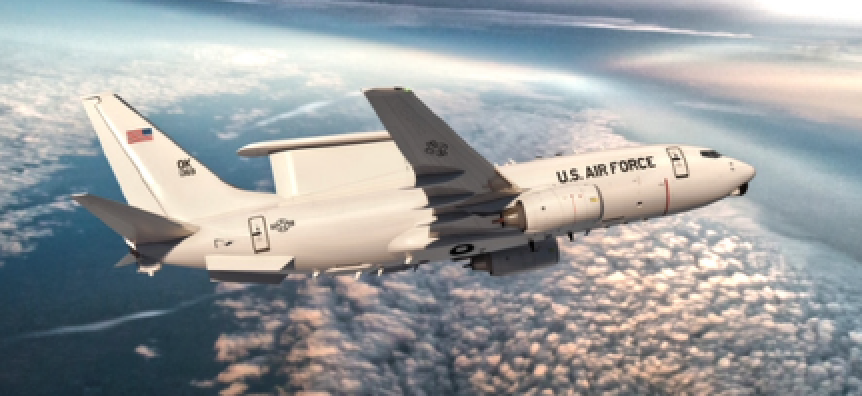
A U.S. Air Force E-7 equipped with the Northrop Grumman
MESA sensor. (Credit: Boeing
When tracking and identifying electronic signals and targets, false alarms or thermal noise can be mistakenly identified by a surveillance radar.
With MESA’s quick updates of the entire landscape, the sensor provides higher quality data — reducing inaccuracies and furthering the edge of the warfighter.
This modern Airborne Active Electronically Scanned Array (AESA) sensor is already in production and deployed for customers worldwide, providing 360-degree situational awareness and flexibility to adapt to missions and environments in all weather conditions.
MESA allows operators to simultaneously focus on priority missions, rapidly revisit targets with increased accuracy and pass relevant information to enable timely Battle Management Command and Control decisions.
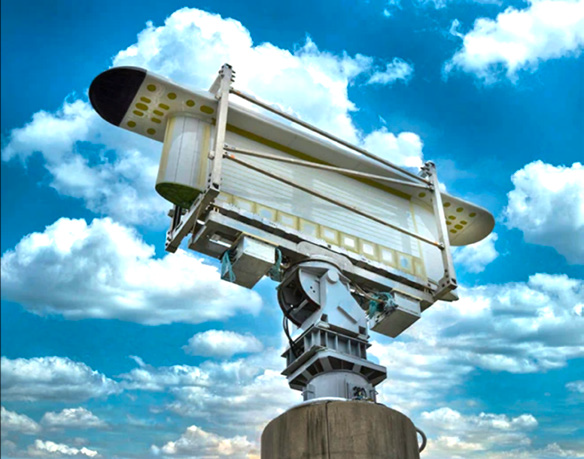
When tracking and identifying electronic signals and targets,
false alarms or thermal noise can be mistakenly identified by
a surveillance radar. With MESA’s quick updates of the entire
landscape, the sensor provides higher quality data – reducing
inaccuracies and furthering the edge of the warfighter.
MESA is on an active production line to address global threats in the modern-day battlespace and evolve to meet future mission requirements. Australia, Turkey and South Korea have fielded the E-7 system, with production underway on the United Kingdom E-7 AEW&C fleet.
“The multifunction MESA sensor will provide the U.S. Air Force with critical multi-domain awareness to enable decision superiority for the range of mission requirements today and into the future.
As we fulfill our promise to the Air Force to rapidly bring unmatched, decisive air battle management sensing capabilities including long range first detect and first engagement in the battlespace, we look forward to enabling global allied interoperability in partnership with Boeing.” Ed Griebel, vice president of airborne surveillance programs, Northrop Grumman
Cobham Satcom rolls out O3b mPOWER transportable terminals to SES
Cobham Satcom and SES have engaged in a contract for a range of O3b mPOWER-enabled, Communications-on-the Pause (COTP) terminals.
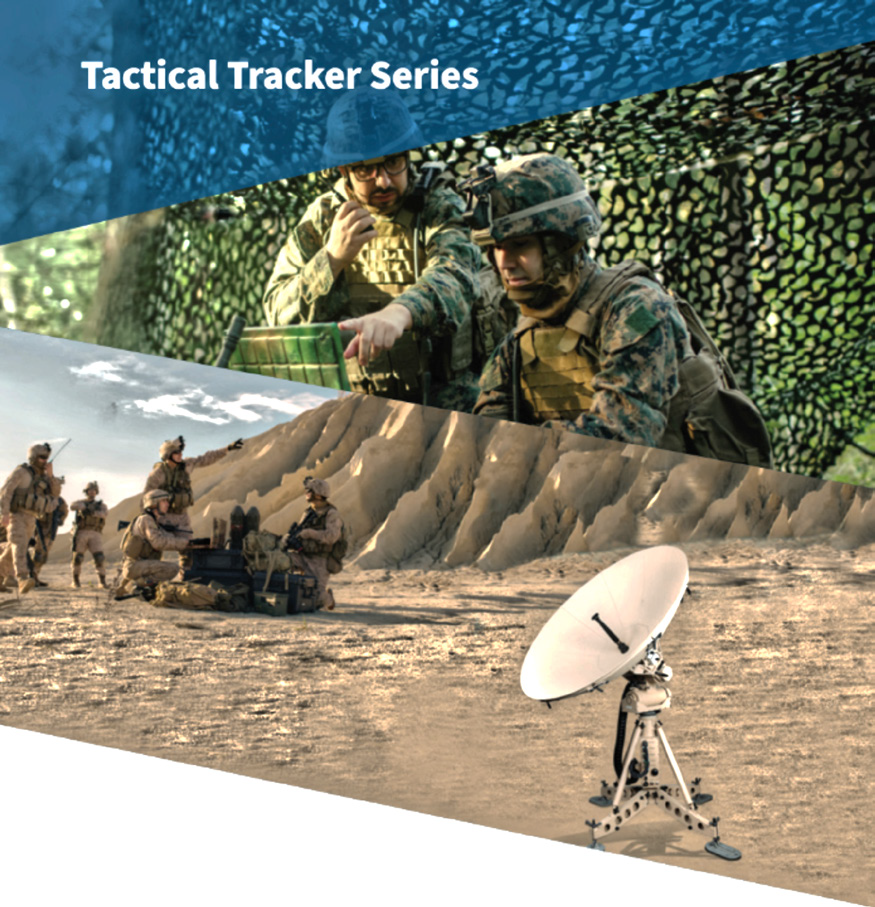
The contract consists of Cobham Satcom’s rugged, man- portable, LEO/MEO/GEO capable, TACTICAL TRACKER terminal series that range in size from 1.35 to 2.64 meters as well as the successful EXPLORER 8120 vehicle mount tracking antenna.
The TACTICAL TRACKER Terminal serves the Government and Defense segment, while Government agencies, carriers, and enterprise customers use the EXPLORER terminals for service augmentation and restoration.
The active tracking TACTICAL TRACKER terminals will enable seamless connectivity across SES’s multi-orbit network of Geostationary (GEO) and MEO satellites, with forward compatibility on SES’s new MEO system O3b mPOWER, as well as SES’s second-generation, high- throughput, low-latency constellation.
Cobham Satcom’s TACTICAL TRACKER terminals are easily converted between Ku- and Ka-band and offer multi-band, multi-orbit, COTP capabilities.
The antennas are transported in rugged man cases and can be set up and operational within 30 minutes.
Additionally, the terminals can be operated in a dual antenna make-before-break configuration, with a rapid retrace capability enabling a single antenna operation while preserving link security.

The O3b mPOWER system represents a tremendous step forward in communication satellite capabilities, providing unprecedented flexibility and throughput.
The new terminals expand Cobham Satcom’s O3b mPOWER terminal portfolio, joining the recently certified Sea Tel 2400 Tri-band terminal for the energy market.
The EXPLORER 8120 is a rugged, field-proven, 1.2 m tracking antenna, available in Ku and Ka-band versions, and easily adapts to a range of vehicles and platforms.
The antenna can be used in single or multi-antenna configurations, with rapid deployment and acquisition within minutes.
“We are pleased to provide new capabilities to SES for the growing COTP segment and to offer proven defense and enterprise solutions. The TACTICAL TRACKERs are the first, man-portable, multi-orbit terminals that actively track across GEO, LEO, and MEO systems, providing mission- critical connectivity to government customers. In addition, the adaptation of the well-proven EXPLORER 8120 also meets the needs of some of the largest telco carriers.”
Kirby Nell, VP of Business Development at Cobham Satcom.
Red Cat Holdings invests in Firestorm
Red Cat Holdings, Inc. (Nasdaq: RCAT) has made a significant financial investment in Firestorm, a company developing the first, completely Modular Unmanned Aerial System (MUAS) that is 3D printed and payload agnostic.
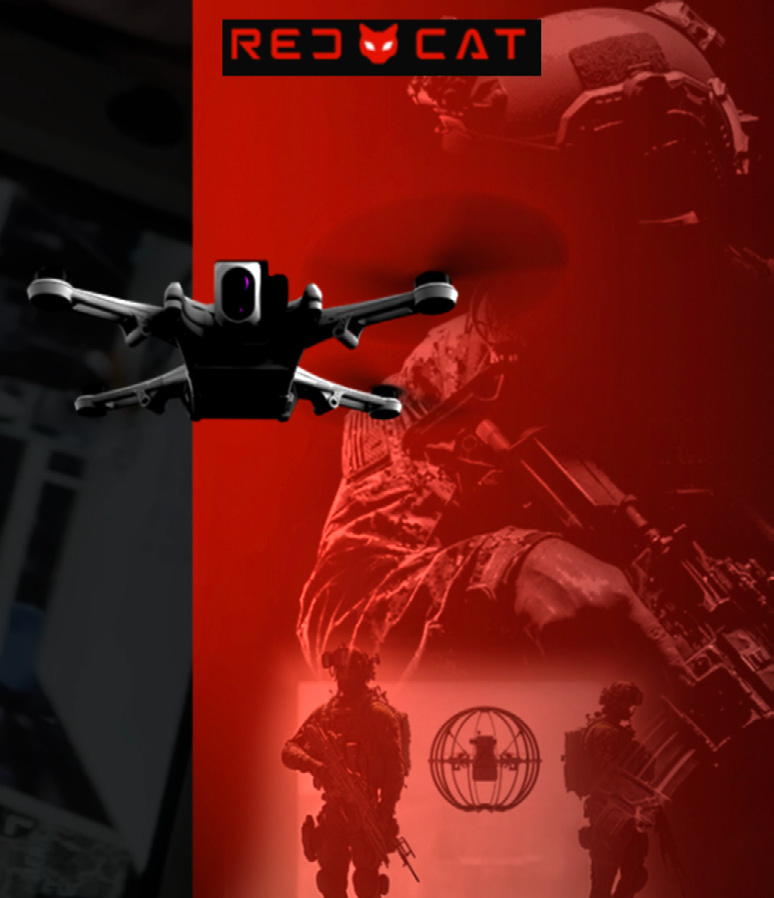
Firestorm is building a new category of fixed-wing UAS with 30-day product iterations, a commitment to open-system architectures plus an additive manufacturing approach that allows them to scale production in an elastic manner.
Firestorm’s founding team has deep industry expertise in additive manufacturing, aerospace, and defense and understands how to build and quickly scale dual-use technology companies.
“Firestorm is changing how UAV’s can be designed, manufactured, and delivered quickly, and the Firestorm system solves a lot of problems for many criti situations. Their long- range and long-duration loitering capabilities are a cost-effective approach to winning in the air. We believe that our Teal 2 drone and the Firestorm UAV could be a great combination for the warfighter. We want to help Firestorm succeed, and this investment may be just the beginning. For example, our large manufacturing facility in Salt Lake City could accelerate the production of Firestorm’s products to meet increased demand.”
Red Cat CEO Jeff Thompson
“We are honored to have Red Cat join us on our journey. Red Cat’s Blue UAS products, their American manufacturing facilities, and their industry knowledge have made them a great partner as we work to scale our business.”
Firestorm CEO Daniel Magy

Red Cat (Nasdaq: RCAT) is a military technology company that integrates robotic hardware and software to provide critical situational awareness and actionable intelligence to on-the-ground warfighters and battlefield commanders. Its mission is to enhance the effectiveness and safety of military operations domestically and globally – and to “Dominate the Night.” Red Cat’s suite of solutions includes Teal Drones, developer of the Golden Eagle, a small unmanned system with the highest resolution imaging for nighttime operations, and Skypersonic, a leading provider of unmanned aircraft for interior spaces and other dangerous environments.
Firestorm is building the future of modular, open-architecture unmanned aerial systems, supporting global requirements to create radically affordable hardware. Firestorm is dedicated to redefining commercial and military expectations for modularity with in-field reconfiguration that supports the widest array of mission needs.



